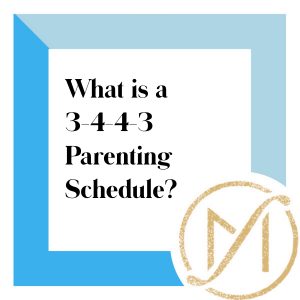One of the major decisions to make during a divorce is how the parenting schedule will work. Many families have a shared parenting schedule, where their children spend significant time with each parent. For many, the “normal” schedule is established, and then the plan is further refined to address special occasions like holidays and vacations. One custody and parenting plan that works for some families is the 3-4-4-3 schedule.
Read on to learn more.
Background on Joint Custody
Joint Custody is what it’s called when a court orders custody of a minor child to both parents. There are two types of joint custody: joint legal custody and joint physical custody. It’s confusing, but it’s important to note that “joint physical custody” does not necessarily mean exactly 50%/50% parenting time. In some cases, joint custody refers to arrangements whereby the child lives with one parent on a primary basis, subject to flexible and liberal visitation with the other parent. In other cases, parents using a truly shared parenting model — like 3-4-3-3, 5-2-2-5, or week on week off — where each parent has substantially equal time with the child each week, or each month. The appropriateness of a particular schedule varies as parenting plans are often influenced by the child’s age, school and work schedules, and the distance between the two parents’ homes.
3-4-4-3 Joint Physical Custody Schedule
3-4-4-3 refers to the time the child spends with each parent. This schedule gives each parent the same 3 days each week with one day (usually a weekend day) which swaps back and forth every week.
In a common version of the schedule:
- One parent has Mondays, Tuesdays, and Wednesdays.
- The other parent has Thursdays, Fridays, and Saturdays.
- Parents swap Sundays.
Sample 3-4-4-3 Weekly Parenting Calendar
Pros and Cons of the 3-4-4-3 Schedule
Like with every parenting schedule, there are pros and cons with a 3-4-4-3.
First let’s get the cons out of the way:
- There’s a relatively short time period between transitions.
- This is a better schedule when parents live relatively close to each other.
- Even with the transition day on the weekend, one parent tends to have most of the weekend time.
- The longest time children have with parents is 4 days.
Onto the pros:
- Kids aren’t away from either parent for longer than 4 days.
- Unless the swap day is a weekday, children are with parents on consistent weekdays. For example, they are always with Parent A on Mondays – Wednesday and with Parent B Thursdays through Saturday. This helps kids remember that “it’s Monday so I’m always with Mom.” It also allows parents to schedule particular lessons or events for consistent days.
- Children get some weekday time and some weekend time with both parents.
Next Steps
For more information about Connecticut divorce and family law, check out our Divorce Information and Facts. If you have questions or want to learn more about how our team of divorce attorneys can help you with your divorce or Post Judgment issue, please contact us here.









